Back to: Mathematics Primary 3
Symmetry comes from a Greek word meaning ‘to measure together’ and is widely used in the study of geometry. Mathematically, symmetry means that one shape becomes exactly like another when you move it in some way: turn, flip or slide. For two objects to be symmetrical, they must be the same size and shape, with one object having a different orientation from the first. There can also be symmetry in one object, such as a face.
When working with symmetry, the initial image is called the pre-image, and the second image is called the image because it is the final step in the process. Just like the answer to a math problem is the final step in that process, the image is what is created when you rotate something 90 degrees or flip it about the x-axis. There are three basic types of symmetry: rotational symmetry, reflection symmetry, and point symmetry.
Line of symmetry
Any line splitting a shape into two parts such that the two parts are the same is called a line of symmetry. These parts are also said to be symmetrical to each other.
For instance, the image below shows a line of symmetry which splits the red outlined shape into two parts that are exactly the same.
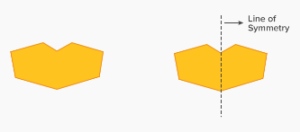
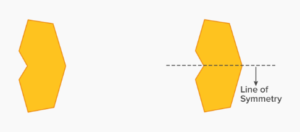
Based on the above examples, we obtain the following observations:
- The sides of the image split up by the line of symmetry, must look the same[c].
- If we fold the paper (on which image is drawn) along the line of symmetry, each part of the image will completely overlap the other part.
Shapes With Lines of Symmentry
Triangles
A Triangle can have 3, or 1 or no lines of symmetry:
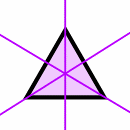

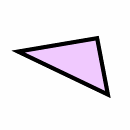
| Equilateral Triangle (all sides equal, all angles equal) | Isosceles Triangle (two sides equal, two angles equal) | Scalene Triangle (no sides equal, no angles equal) | ||
| 3 Lines of Symmetry | 1 Line of Symmetry | No Lines of Symmetry |
Quadrilaterals
Different types of Quadrilaterals (a 4-sided plane shape):



| Square (all sides equal, all angles 90°) | Rectangle (opposite sides equal, all angles 90°) | Irregular Quadrilateral | ||
| 4 Lines of Symmetry | 2 Lines of Symmetry | No Lines of Symmetry |


| Kite | Rhombus (all sides equal length) | |
| 1 Line of Symmetry | 2 Lines of Symmetry |
Regular Polygons
A regular polygon has all sides equal, and all angles equal:
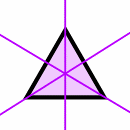



has 6 Lines of Symmetry

has 7 Lines of Symmetry

And the pattern continues:
- A regular polygon of 9 sides has 9 Lines of Symmetry
- A regular polygon of 10 sides has 10 Lines of Symmetry
- …
- A regular polygon of “n” sides has “n” Lines of Symmetry
| Circle A line (drawn at any angle) that goes through its center is a Line of Symmetry. So a Circle has infinite Lines of Symmetry.
|

The Triangle

The triangle is a shape that is formed by 3 straight lines that are called sides. There are different ways of classifying triangles, according to their sides or angles.
- According to their angles:
- Right triangle: the largest of the 3 angles is a right angle.
- Acute Triangle: the largest of the 3 angles is an acute angle (less than 90 degrees).
- Obtuse Triangle: the largest of the 3 angles is an obtuse angle (more than 90 degrees).
- According to their sides:
- Equilateral Triangle: all 3 sides are the same length.
- Isosceles Triangle: it has 2 (or more) sides that are of equal length. (An equilateral triangle is also isosceles.)
- Scalene Triangle: no 2 sides are of equal measure.
The Rectangle

The rectangle is a shape that has 4 sides. A rectangle has two equal sides of one length and two equal sides of a different length. A rectangle is like a stretched square. The distinguishing characteristic of a rectangle is that all 4 angles measure 90 degrees.
The Square
A square has four sides, but not just any four sides. A square’s four sides are all the same length. A square with one-inch sides is smaller than a square with three-inch sides because one is less than three. A square also has four corners. The square is a type of rectangle, but also a type of rhombus. It has characteristics of both of these. That is to say, all 4 angles are right angles, and all 4 sides are equal in length.

